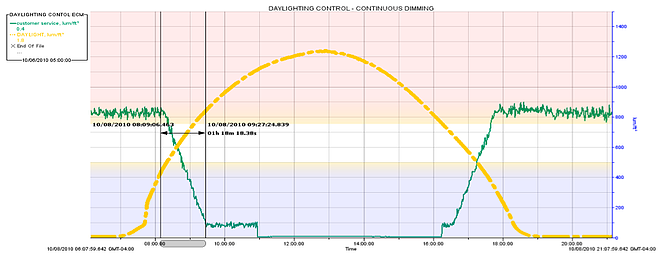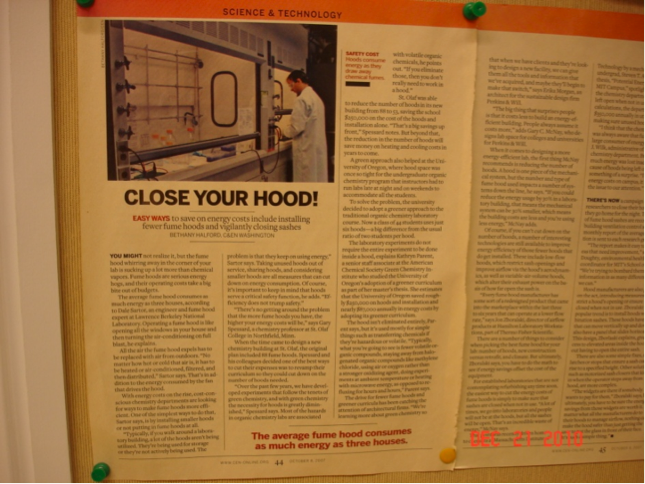Project-specific energy efficiency baselines, where the starting point for building efficiency is adjusted based on knowledge from our past successes, will become the norm as the energy efficiency market becomes more sophisticated. You read it here first.
I make this prediction based on my onsite measurement and verification experience (M&V) and participation in baseline studies. Let’s examine three examples for a look forward at the efficiency planning landscape in years to come. Project-specific baseline issues apply to existing buildings that have received prior efficiency upgrades and to new buildings subject to increasingly stringent energy standards. Whether efficient systems are installed due to efficiency program incentives or changing attitudes toward responsible energy use, the use of accurate baselines is ultimately essential to successful projects.
Daylight Harvesting Controls in the Baseline for Efficient Lighting Upgrades
Energy efficient lighting savings are often based on ‘always on’ operating hours, however this may not actually be the case. Using an ‘always on’ point of reference can create inflated expectations of cost savings. Whether controlled manually by occupants, by code-required controls, or other automatic controls, when the lights are off, they are not saving energy compared to less efficient fixtures, or compared to a code‑maximum allowed lighting power density (LPD).
It is not unusual to find lighting controls already installed, such as daylight harvesting, occupancy sensors, and multilevel switching. In fact, automatic lighting control for buildings larger than 5,000 square feet has been required by ASHRAE 90.1 since 1999, and with the adoption of ASHRAE/IES 90.1-2010 automatic lighting controls are even more stringent. In one real world M&V project it was found that the annual energy savings for an efficient lighting project was on the order of 150,000 kWh lower for the actual installed system than for a reference system that was always on. The lower run hours were due to a daylight dimming system that was standard practice for the building owner.
In this example, an ‘always on’ assumption overestimated the impact of the better lights. That said, the efficient fixtures saved a verified 1,630,596 kWh annually, even with the daylighting controls in place. Clearly the efficient fixtures had a substantial impact, however the absolute cost savings reduction over more years due to an incorrect baseline could be significant on a net present value basis. Using project specific baseline hours of operation is therefore essential to avoid possible perceptions of underperforming efficiency investments in the long term.
Productive next steps toward creating a culture of efficient buildings will depend on new benchmarks such as verified success and persistence of efficient measures. In the lighting example above, will the fixtures continue to be replaced with efficient products? It will become increasingly important to shift focus from initial implementation, which can be likened to ‘triage’ for many projects, to a more mature model of responsible energy use. This new model has an emphasis on design review, successful implementation, and ongoing commitment to preserving the energy efficiency infrastructure through real time energy use monitoring systems and continuous commissioning that compares historic use to current, and identifies and attacks upward trends in building energy use.
Variable Flow Fan Systems as Baseline for Outside Air Conservation Measures
In another real world example, fan system sizing in a variable speed integrated lab exhaust system resulted in underestimated fan energy savings by a factor of 200%. Variable speed laboratory exhaust systems are a common option used to satisfy code requirements when the total fume hood exhaust rate is 15,000 cubic feet per minute (cfm). Outside airflow is reduced based on the quantity of hoods in use, saving fan energy in addition to heating and cooling energy. However, the amount of fan energy saved depends on system sizing.
It is not unusual to find installed mechanical systems that are larger than needed, frequently running at part loads less than 50% of the original design due to differences between site conditions and conservative design assumptions. This means that the actual input power of the fan is in a lower range than expected, and fan energy savings are smaller than they would be for a more fully loaded system due to the fan system affinity laws for power and airflow.
‘Right sizing’ in variable speed systems maximizes savings compared with an oversized, partly loaded system. Regardless of whether the savings were smaller or larger than the original estimate, savings calculated based on variable speed baseline systems may be substantially different than expected unless the actual operating point brake horsepower of the baseline system, after balancing, is considered.
VFD in Constant Volume Applications
Savings based on nameplate motor horsepower, even if reduced by a factor to account for motor upsizing, has been shown in our M&V work to overestimate savings when VFDs (Variable Frequency Drives) are installed to permanently reduce the speed of a fan or pump to a lower-than-design constant speed. Future retrocommissioning savings for existing equipment may be significantly less than in the ‘old’ days when constant volume baselines based on the full design brake horsepower provided highly favorable financial justification. Energy savings calculations should be based on the actual operating brake horsepower after balancing of the baseline system.
The Future
Our successes in reducing energy use are paving the way toward a new vision of responsible resource utilization. By championing innovative design and controls implementation, and preserving our hard-won efficient infrastructure, our buildings can advance beyond a collection of efficient products and systems toward a built environment that embodies appropriate use of the Earth’s resources.





